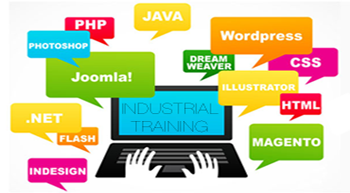Corporate Training

Skill Enhancement and Professional Development:
Corporate training serves as a platform for employees to enhance their skills and competencies. Whether it's technical skills required for specific job roles or soft skills such as communication, leadership, and problem-solving, investing in employee development ensures that the workforce remains proficient and adaptable. Through workshops, seminars, online courses, and on-the-job training, employees have the opportunity to continuously grow and improve, contributing to their professional development and overall job satisfaction.
Alignment with Organizational Goals:
Successful organizations understand the importance of aligning training initiatives with strategic objectives. By identifying key areas where skills development is needed to support business goals, companies can design targeted training programs that address specific needs. For instance, if the organization is aiming to expand into new markets, sales and marketing training may be prioritized to equip employees with the necessary skills to drive growth. This alignment ensures that training investments directly contribute to the company's success and competitiveness.
Enhanced Employee Engagement and Retention:
Investing in employee training demonstrates a commitment to their growth and development, leading to higher levels of engagement and retention. When employees feel valued and supported through training opportunities, they are more likely to be motivated and invested in their work. Additionally, training programs provide employees with a sense of progression and advancement within the organization, reducing turnover and fostering loyalty. As a result, companies that prioritize training often enjoy a more engaged and stable workforce.
Improved Performance and Productivity:
Well-designed training programs have a direct impact on employee performance and productivity. By equipping employees with the skills and knowledge they need to excel in their roles, organizations can expect to see improvements in efficiency, quality, and output. For example, training in new technologies or processes can streamline workflows and eliminate bottlenecks, leading to greater productivity. Similarly, leadership development programs can empower managers to effectively lead and motivate their teams, driving performance across the organization.
Adaptability to Change and Innovation:
In today's rapidly evolving business environment, organizations must be agile and adaptable to stay competitive. Corporate training plays a crucial role in preparing employees to navigate change and embrace innovation. By providing training on topics such as change management, agility, and creativity, companies can equip their workforce with the skills and mindset needed to thrive in times of uncertainty. Moreover, fostering a culture of innovation through training encourages employees to generate new ideas and solutions, driving continuous improvement and competitive advantage.
Cultivation of a Learning Culture:
Corporate training initiatives contribute to the cultivation of a learning culture within the organization. When learning and development opportunities are readily available and encouraged, employees are more likely to take ownership of their professional growth. This culture of learning extends beyond formal training programs to include knowledge sharing, mentorship, and continuous feedback. As a result, employees become more engaged, innovative, and collaborative, contributing to a positive and dynamic work environment.
Corporate training serves as a platform for employees to enhance their skills and competencies. Whether it's technical skills required for specific job roles or soft skills such as communication, leadership, and problem-solving, investing in employee development ensures that the workforce remains proficient and adaptable. Through workshops, seminars, online courses, and on-the-job training, employees have the opportunity to continuously grow and improve, contributing to their professional development and overall job satisfaction.
Alignment with Organizational Goals:
Successful organizations understand the importance of aligning training initiatives with strategic objectives. By identifying key areas where skills development is needed to support business goals, companies can design targeted training programs that address specific needs. For instance, if the organization is aiming to expand into new markets, sales and marketing training may be prioritized to equip employees with the necessary skills to drive growth. This alignment ensures that training investments directly contribute to the company's success and competitiveness.
Enhanced Employee Engagement and Retention:
Investing in employee training demonstrates a commitment to their growth and development, leading to higher levels of engagement and retention. When employees feel valued and supported through training opportunities, they are more likely to be motivated and invested in their work. Additionally, training programs provide employees with a sense of progression and advancement within the organization, reducing turnover and fostering loyalty. As a result, companies that prioritize training often enjoy a more engaged and stable workforce.
Improved Performance and Productivity:
Well-designed training programs have a direct impact on employee performance and productivity. By equipping employees with the skills and knowledge they need to excel in their roles, organizations can expect to see improvements in efficiency, quality, and output. For example, training in new technologies or processes can streamline workflows and eliminate bottlenecks, leading to greater productivity. Similarly, leadership development programs can empower managers to effectively lead and motivate their teams, driving performance across the organization.
Adaptability to Change and Innovation:
In today's rapidly evolving business environment, organizations must be agile and adaptable to stay competitive. Corporate training plays a crucial role in preparing employees to navigate change and embrace innovation. By providing training on topics such as change management, agility, and creativity, companies can equip their workforce with the skills and mindset needed to thrive in times of uncertainty. Moreover, fostering a culture of innovation through training encourages employees to generate new ideas and solutions, driving continuous improvement and competitive advantage.
Cultivation of a Learning Culture:
Corporate training initiatives contribute to the cultivation of a learning culture within the organization. When learning and development opportunities are readily available and encouraged, employees are more likely to take ownership of their professional growth. This culture of learning extends beyond formal training programs to include knowledge sharing, mentorship, and continuous feedback. As a result, employees become more engaged, innovative, and collaborative, contributing to a positive and dynamic work environment.





















